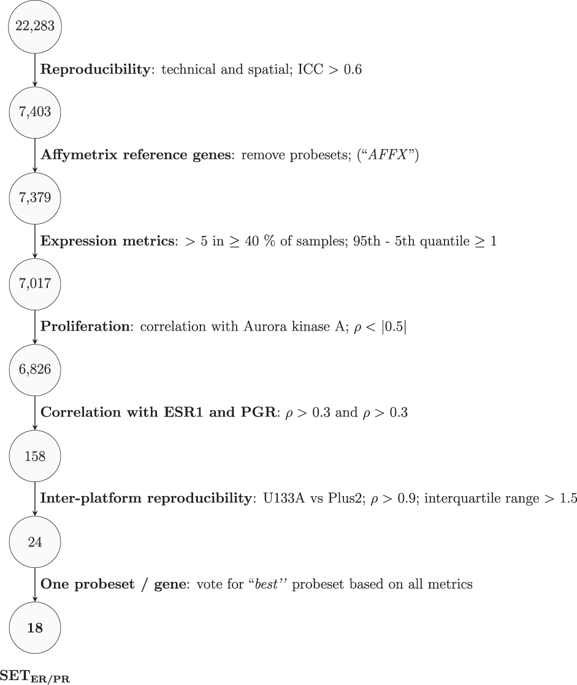npj Breast Cancer ( IF 5.9 ) Pub Date : 2019-05-30 , DOI: 10.1038/s41523-019-0111-0 Bruno V Sinn 1, 2 , Chunxiao Fu 1 , Rosanna Lau 1 , Jennifer Litton 3 , Tsung-Heng Tsai 1 , Rashmi Murthy 3 , Alda Tam 4 , Eleni Andreopoulou 3, 5 , Yun Gong 1 , Ravi Murthy 4 , Rebekah Gould 1 , Ya Zhang 1 , Tari A King 6 , Agnes Viale 7 , Victor Andrade 7, 8 , Dilip Giri 7 , Roberto Salgado 9, 10 , Ioanna Laios 11 , Christos Sotiriou 12 , Esmeralda C Marginean 13 , Danielle N Kwiatkowski 3 , Rachel M Layman 3 , Daniel Booser 3 , Christos Hatzis 14 , V Vicente Valero 3 , W Fraser Symmans 1

|
There is a clinical need to predict sensitivity of metastatic hormone receptor-positive and HER2-negative (HR+/HER2−) breast cancer to endocrine therapy, and targeted RNA sequencing (RNAseq) offers diagnostic potential to measure both transcriptional activity and functional mutation. We developed the SETER/PR index to measure gene expression microarray probe sets that were correlated with hormone receptors (ESR1 and PGR) and robust to preanalytical and analytical influences. We tested SETER/PR index in biopsies of metastastic HR+/HER2− breast cancer against the treatment outcomes in 140 patients. Then we customized the SETER/PR assay to measure 18 informative, 10 reference transcripts, and sequence the ligand-binding domain (LBD) of ESR1 using droplet-based targeted RNAseq, and tested that in residual RNA from 53 patients. Higher SETER/PR index in metastatic samples predicted longer PFS and OS when patients received endocrine therapy as next treatment, even after adjustment for clinical-pathologic risk factors (PFS: HR 0.534, 95% CI 0.299 to 0.955, p = 0.035; OS: HR 0.315, 95% CI 0.157 to 0.631, p = 0.001). Mutated ESR1 LBD was detected in 8/53 (15%) of metastases, involving 1−98% of ESR1 transcripts (all had high SETER/PR index). A signature based on probe sets with good preanalytical and analytical performance facilitated our customization of an accurate targeted RNAseq assay to measure both phenotype and genotype of ER-related transcription. Elevated SETER/PR was associated with prolonged sensitivity to endocrine therapy in patients with metastatic HR+/HER2− breast cancer, especially in the absence of mutated ESR1 transcript.
中文翻译:

SETER / PR:对转移性乳腺癌的内分泌治疗敏感的18基因预测器。
临床上需要预测转移性激素受体阳性和HER2阴性(HR + / HER2-)乳腺癌对内分泌治疗的敏感性,靶向RNA测序(RNAseq)提供了测量转录活性和功能突变的诊断潜力。我们开发了SET ER / PR指数来测量与激素受体(ESR1和PGR)相关的基因表达微阵列探针组,并且对分析和分析的影响很强。我们测试了转移性HR + / HER2-乳腺癌活检中的SET ER / PR指数与140例患者的治疗结果之间的关系。然后我们定制了SET ER / PR检测方法可测量18种信息性,10种参考转录本,并使用基于液滴的靶向RNAseq对ESR1的配体结合域(LBD)进行测序,并在53名患者的残留RNA中进行了测试。即使对临床病理危险因素进行了调整(PFS:HR 0.534,95%CI 0.299 to 0.955,p = 0.035; OS),转移性样本中较高的SET ER / PR指数越高,患者接受内分泌治疗作为下一步治疗时的PFS和OS越长(PFS:HR 0.534,95%CI 0.299 to 0.955,p = 0.035; OS :HR 0.315,95%CI 0.157至0.631,p = 0.001)。在8/53(15%)的转移中检测到突变的ESR1 LBD,涉及ESR1转录本的1–98%(均具有较高的SET ER / PR指数)。基于具有良好的分析和分析性能的探针集的签名有助于我们定制精确的靶向RNAseq分析方法,以测量ER相关转录的表型和基因型。SET ER / PR升高与转移性HR + / HER2-乳腺癌患者对内分泌治疗的敏感性延长有关,尤其是在没有ESR1转录本突变的情况下。



























 京公网安备 11010802027423号
京公网安备 11010802027423号